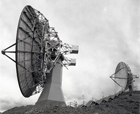Institute for Telecommunication Sciences / About ITS / Resources / Table Mountain / History / Chapter 3: Tropospheric Telecommunications Laboratory
Chapter 3: Tropospheric Telecommunications Laboratory
The Tropospheric Telecommunications Laboratory conducts research on the propagation of electromagnetic waves as affected by the troposphere and its boundaries, including studies of the electromagnetic properties of the medium and the prediction of transmission loss and interference environment. This involves research and systems studies throughout the entire electromagnetic spectrum. This laboratory also is concerned with work at optical and infrared frequencies as well as studies of the electromagnetic properties of the non-ionized lower atmosphere of the earth. The Table Mountain Field Site is utilized for a number of experimental programs in this laboratory.
Laser Experiments (Optical Propagation Facilities)
The small shelter at the south edge of the mesa houses the laser-beam transmitter which is used for studies of atmospheric effects over paths of one to 150 km. The photograph shows the servo-controlled mount, the laser, and the beam-expanding telescope. The mount is arranged so that it can be controlled by a radio signal from the target end of the beam in order to keep the beam centered on the detector despite variable atmospheric refraction. The light source is a 10 mw. helium-neon continuous gas laser. The telescope is constructed of invar rods and is, in addition, temperature compensated. This careful construction permits accurate focusing of the laser beam regardless of the degree of disturbance of the atmosphere. Observations of the beam can be made, night or day, by portable equipment which is used at a number of distances from Table Mountain, or by permanent equipment at Green Mountain Mesa, just behind the main laboratory building in Boulder.
Building T-6 is being prepared as the transmitting site for open-air optical interferometry experiments. No equipment has yet been installed in the building but several concrete piers have been constructed in a line stretching off to the northeast. The piers will be used to hold one of the mirrors of the interferometer, thus permitting the study of optical phase fluctuations produced by atmospheric paths of various lengths.
Tropospheric Receiving Facility
Two general purpose parabolic antennas with 18.3 meter (60 ft.) diameters are located on Table Mountain at T-22. These antennas are steerable in azimuth and elevation and have been used at frequencies ranging from 400 MHz to 11 GHz. Examples of experimental uses include tropospheric scatter on paths up to 770 kilometers in length, diffraction measurements over a mountain ridge, measurement of bistatic scattering cross sections of thunderstorms, and evaluation of typical characteristics of large antennas.
The most recent experimental program involves the measurement of thermal radio emissions (not lightning discharges) from thunderstorm cells. A sensitive radiometer mounted at the focus of one of the large antennas and operating at 10.7 GHz detects the noise-like energy which is radiated from the liquid or frozen water in a thunderstorm. The antenna beam is swept across the storm in a regular pattern so that contours of noise intensity can be plotted. These contours, used with weather radar data, contain information that is useful in both telecommunication problems and the study of convective cells per se. Of particular interest to earth-space communication are (1) noise degradation of earth-station receiving systems, (2) total attenuation through the storm, and (3) relationship between attenuation and radar reflectivity. Preliminary measurements were made in July and August 1966, with a more complete experiment planned for the thunderstorm season of 1967.
Diffraction Experiments
Within recent years there has been considerable interest in and much use made of the obstacle diffraction mode of tropospheric radio propagation, particularly in communication systems installed for the Department of Defense. For this reason, experiments designed to improve prediction methods for this type of circuit have received substantial support.
During the period between 1959 and 1965, the Table Mountain receiving site has been used as one terminal of a long experimental diffraction path which extends 223 km from a site near Beulah in Southern Colorado over Pikes Peak to Table Mountain north of Boulder. This path is situated along the front range of the Rocky Mountains so the terrain between each terminal and the obstacle is fairly open. This results in a path having a single obstacle. Furthermore, the knife-edge is accessible by road to its summit. This has made it possible to monitor the signal incident upon the diffracting obstacle in order to determine the mechanism responsible for fading observed over the entire path.
The frequencies used in the diffraction experiments were 0.75 GHz, 0.91 GHz, 4.6 GHz, and 9.2 GHz. In addition to long term measurements of received field intensity, the following investigations were made:
-
correlation between signals received on horizontally and vertically spaced antennas
-
height-gain effects
-
distribution of fields in a plane perpendicular to the radio path.




